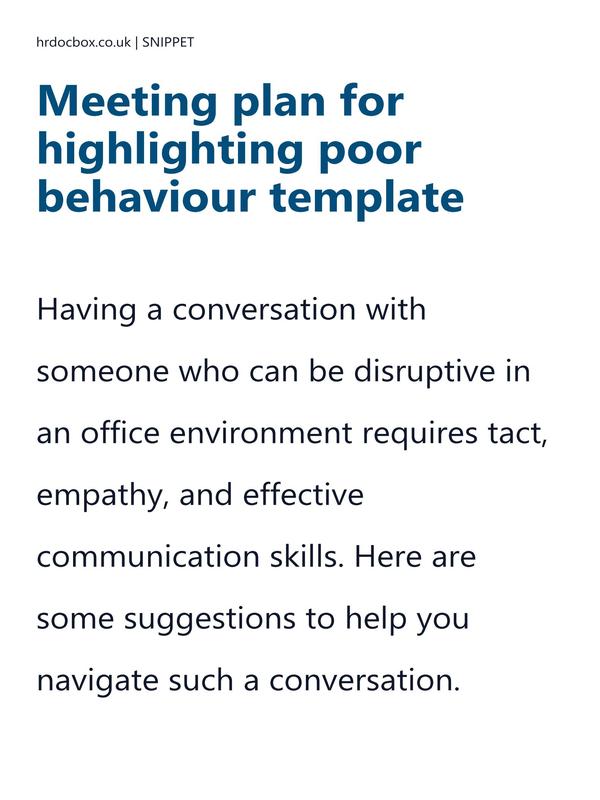Meeting plan for highlighting poor behaviour template


Our Meeting Plan for Highlighting Poor Behaviour Template streamlines discussions, addressing behavioural issues constructively for a positive work culture.
- Includes Meeting plan for highlighting poor behaviour template + 12 months’ access, with all updates to this page provided free of charge and notified to you.
- UK-specific accuracy.
- 375 words over 2 pages.
- Last updated 28/10/2025.
- Format: Word / plain text / email.
- Delivery: Instant download after purchase (no physical item).
- Access: Download link shown here after checkout.
- This Meeting plan for highlighting poor behaviour template will SAVE you up to 1 hour drafting & research. Save cost. Reduce risk.
Meeting plan for highlighting poor behaviour
Having a conversation with someone who can be disruptive in an office environment requires tact, empathy, and effective communication skills. Here are some suggestions to help you navigate such a conversation.
Remember, maintaining a professional and respectful approach throughout the conversation is key. Your goal should be to foster a constructive dialogue and find a resolution that benefits everyone involved.
-
Choose the right time and place: Find a suitable time and a private location where both of you can speak without distractions or interruptions.
-
Remain calm and composed: Approach the conversation with a calm and positive demeanor. Avoid being confrontational or aggressive, as it may escalate the situation.
This is a 30% preview of the Meeting plan for highlighting poor behaviour template. For instant full access, purchase this item or a parent bundle.
Meeting plan for highlighting poor behaviour template
The purpose of a Meeting Plan for Highlighting Poor Behaviour Template is to provide a structured and organized approach for addressing and discussing poor behavior or disruptive actions with an employee or team member.
The template outlines key steps and guidelines to follow during the meeting, such as choosing the right time and place, remaining composed, focusing on specific behaviours, using "I" statements, active listening, expressing the impact, offering solutions and support, setting clear expectations, and documenting the discussion for future reference.
The meeting plan template helps ensure a constructive and fair conversation, fostering open communication, and addressing behavioral issues effectively to promote a positive work environment and productivity.
Practical application of a Meeting plan for highlighting poor behaviour template
- The Meeting plan for highlighting poor behaviour template should be actioned / delivered prior to carrying out the meeting.
- It is sent / delivered by an employer / HR team to an employee.
Compliance
Compliance
This Meeting plan for highlighting poor behaviour template incorporates relevant UK laws and HR standards, including those listed below:
-
Employment Rights Act 1996: Provides guidelines for conducting fair and reasonable disciplinary procedures and promoting effective communication between employers and employees.
-
Equality Act 2010: Ensures fair treatment during disciplinary processes, prohibiting discrimination based on protected characteristics when addressing poor behavior.
-
ACAS Code of Practice on Disciplinary and Grievance Procedures: Offers best practices for handling disciplinary matters, emphasizing the importance of constructive communication and fair treatment.
-
Data Protection Act 2018: Ensures that employee data related to disciplinary discussions, including poor behavior concerns, is handled securely and confidentially.
Meeting plan for highlighting poor behaviour workflow
Meeting plan for highlighting poor behaviour workflow
Check which resources should be implemeted before and/or after the Meeting plan for highlighting poor behaviour template, to understand the workflow.
Meeting for highlighting an employees disruptive behaviour script
Our Meeting for Highlighting Employee Disruptive Behaviour Script Template ensures structured discussions, addressing concerns professionally.
Frequently Asked Questions about a Meeting plan for highlighting poor behaviour template
Frequently Asked Questions about a Meeting plan for highlighting poor behaviour template
-
Can I use this template in my small business?
Yes. The Meeting plan for highlighting poor behaviour template is designed to be flexible and suitable for organisations of all sizes, including small businesses and charities. It follows UK employment law best practice, so even if you don't have an in-house HR team, you can confidently apply it.
-
Is the Meeting plan for highlighting poor behaviour template compliant with 2026 UK employment law?
Absolutely. All of our templates are drafted with the latest ACAS guidance and UK employment legislation in mind. We review and update them regularly, so you can be confident they remain compliant.
-
Can I customise it for my organisation?
Yes, we highlight the areas that you need to update with your own details, and where you need to make decisions to suit your situation. This saves you time and ensures that you meet best practice.
-
Do I get instant access?
Yes. Once purchased, you'll be able to download it instantly. Templates are provided in editable Word or Excel format so you can customise them easily, and in PDF format for easy sharing.
-
What if I need more help, not just this template?
If you're looking for broader support, we also offer toolkits and library bundles that include this template, along with other HR templates and policies for fully managing your situation. These may be more cost-effective if you need deeper advice.
-
Why should I use this, and not AI to generate this template?
The risk of using a free AI-generated template 'without review' includes your legal exposure, missing context, and no awareness of the wider process. Purchasing from us mitigates that risk.
